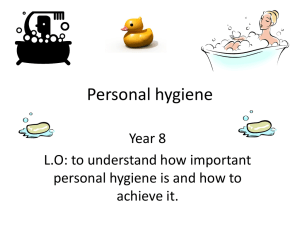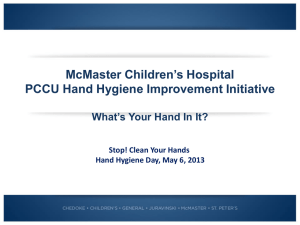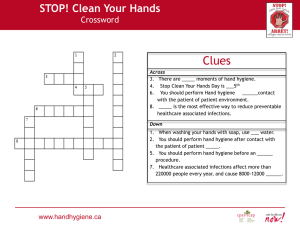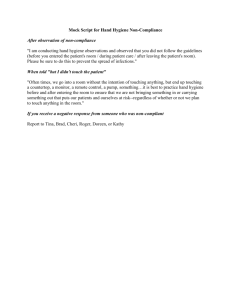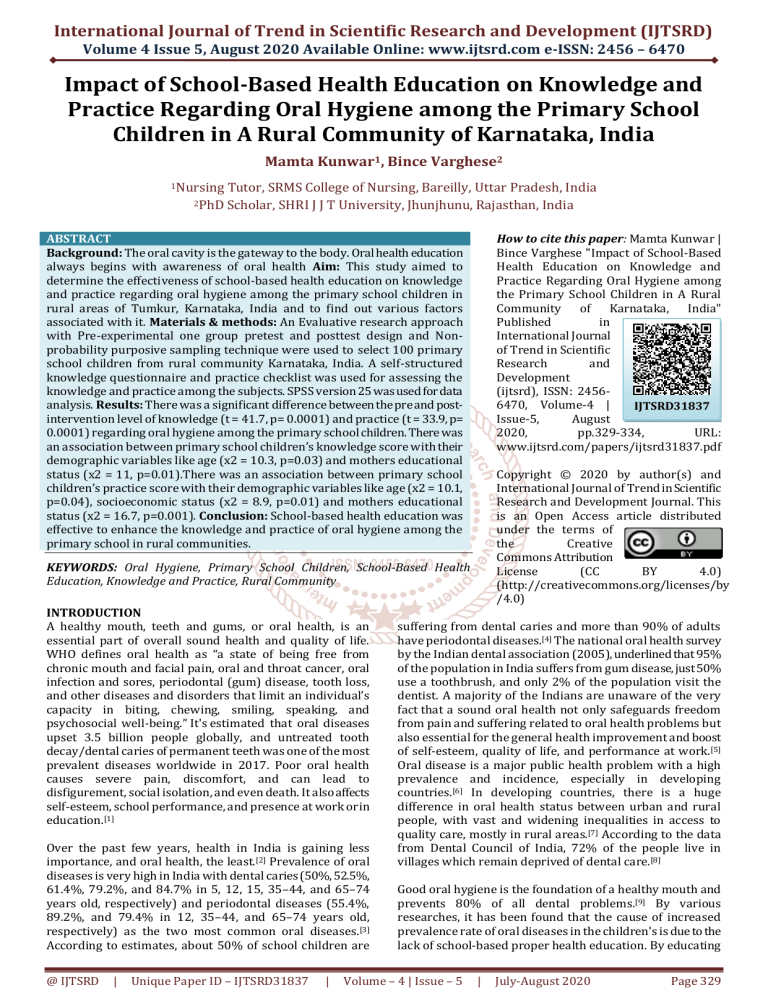
International Journal of Trend in Scientific Research and Development (IJTSRD)
Volume 4 Issue 5, August 2020 Available Online: www.ijtsrd.com e-ISSN: 2456 – 6470
Impact of School-Based Health Education on Knowledge and
Practice Regarding Oral Hygiene among the Primary School
Children in A Rural Community of Karnataka, India
Mamta Kunwar1, Bince Varghese2
1Nursing
2PhD
Tutor, SRMS College of Nursing, Bareilly, Uttar Pradesh, India
Scholar, SHRI J J T University, Jhunjhunu, Rajasthan, India
ABSTRACT
Background: The oral cavity is the gateway to the body. Oral health education
always begins with awareness of oral health Aim: This study aimed to
determine the effectiveness of school-based health education on knowledge
and practice regarding oral hygiene among the primary school children in
rural areas of Tumkur, Karnataka, India and to find out various factors
associated with it. Materials & methods: An Evaluative research approach
with Pre-experimental one group pretest and posttest design and Nonprobability purposive sampling technique were used to select 100 primary
school children from rural community Karnataka, India. A self-structured
knowledge questionnaire and practice checklist was used for assessing the
knowledge and practice among the subjects. SPSS version 25 was used for data
analysis. Results: There was a significant difference between the pre and postintervention level of knowledge (t = 41.7, p= 0.0001) and practice (t = 33.9, p=
0.0001) regarding oral hygiene among the primary school children. There was
an association between primary school children’s knowledge score with their
demographic variables like age (x2 = 10.3, p=0.03) and mothers educational
status (x2 = 11, p=0.01).There was an association between primary school
children’s practice score with their demographic variables like age (x2 = 10.1,
p=0.04), socioeconomic status (x2 = 8.9, p=0.01) and mothers educational
status (x2 = 16.7, p=0.001). Conclusion: School-based health education was
effective to enhance the knowledge and practice of oral hygiene among the
primary school in rural communities.
How to cite this paper: Mamta Kunwar |
Bince Varghese "Impact of School-Based
Health Education on Knowledge and
Practice Regarding Oral Hygiene among
the Primary School Children in A Rural
Community of Karnataka, India"
Published
in
International Journal
of Trend in Scientific
Research
and
Development
(ijtsrd), ISSN: 24566470, Volume-4 |
IJTSRD31837
Issue-5,
August
2020,
pp.329-334,
URL:
www.ijtsrd.com/papers/ijtsrd31837.pdf
Copyright © 2020 by author(s) and
International Journal of Trend in Scientific
Research and Development Journal. This
is an Open Access article distributed
under the terms of
the
Creative
Commons Attribution
License
(CC
BY
4.0)
(http://creativecommons.org/licenses/by
/4.0)
KEYWORDS: Oral Hygiene, Primary School Children, School-Based Health
Education, Knowledge and Practice, Rural Community
INTRODUCTION
A healthy mouth, teeth and gums, or oral health, is an
essential part of overall sound health and quality of life.
WHO defines oral health as “a state of being free from
chronic mouth and facial pain, oral and throat cancer, oral
infection and sores, periodontal (gum) disease, tooth loss,
and other diseases and disorders that limit an individual’s
capacity in biting, chewing, smiling, speaking, and
psychosocial well-being.” It's estimated that oral diseases
upset 3.5 billion people globally, and untreated tooth
decay/dental caries of permanent teeth was one of the most
prevalent diseases worldwide in 2017. Poor oral health
causes severe pain, discomfort, and can lead to
disfigurement, social isolation, and even death. It also affects
self-esteem, school performance, and presence at work or in
education.[1]
Over the past few years, health in India is gaining less
importance, and oral health, the least.[2] Prevalence of oral
diseases is very high in India with dental caries (50%, 52.5%,
61.4%, 79.2%, and 84.7% in 5, 12, 15, 35–44, and 65–74
years old, respectively) and periodontal diseases (55.4%,
89.2%, and 79.4% in 12, 35–44, and 65–74 years old,
respectively) as the two most common oral diseases. [3]
According to estimates, about 50% of school children are
@ IJTSRD
|
Unique Paper ID – IJTSRD31837
|
suffering from dental caries and more than 90% of adults
have periodontal diseases.[4] The national oral health survey
by the Indian dental association (2005), underlined that 95%
of the population in India suffers from gum disease, just 50%
use a toothbrush, and only 2% of the population visit the
dentist. A majority of the Indians are unaware of the very
fact that a sound oral health not only safeguards freedom
from pain and suffering related to oral health problems but
also essential for the general health improvement and boost
of self-esteem, quality of life, and performance at work. [5]
Oral disease is a major public health problem with a high
prevalence and incidence, especially in developing
countries.[6] In developing countries, there is a huge
difference in oral health status between urban and rural
people, with vast and widening inequalities in access to
quality care, mostly in rural areas.[7] According to the data
from Dental Council of India, 72% of the people live in
villages which remain deprived of dental care.[8]
Good oral hygiene is the foundation of a healthy mouth and
prevents 80% of all dental problems.[9] By various
researches, it has been found that the cause of increased
prevalence rate of oral diseases in the children's is due to the
lack of school-based proper health education. By educating
Volume – 4 | Issue – 5
|
July-August 2020
Page 329
International Journal of Trend in Scientific Research and Development (IJTSRD) @ www.ijtsrd.com eISSN: 2456-6470
the population about their oral health we can prevent the
various oral diseases at the primary level.[10,11]
India with its high population growth rate faces many
challenges in delivering its oral health needs. Since 1940, the
prevalence of dental caries in 5-year-old and 12-year-old
schoolchildren in India has been progressively increasing.[12]
A large number of children and their parents in this country
lack knowledge about the prevention of the most common
oral diseases. A study reported that oral health knowledge
among Indian children was low when compared to their
Western counterparts.[13] School is an important podium for
learning. It not only contributes to an individual's education
but also to their health and health-related behaviour.[14] The
WHO has provided “information series on school health” to
advocate “health-promoting schools.” They have also
executed strategies for oral health promotion in schools.[15]
Very limited experimental studies have been conducted to
improve knowledge and practices of primary school children
about oral hygiene in particular rural areas. This is the main
reason researchers conduct the present study. The
objectives of the study were to assess the effectiveness of
school based health education on knowledge and practice
regarding oral hygiene among the primary school children in
rural areas at Tumkur, Karnataka, India and to find out the
association between demographic variables with it.
MATERIAL AND METHOD
A evaluative research approach with Pre-Experimental, One
group pretest posttest Design with non-probability
purposive sampling method was used for the selection of
100 primary school children from rural communities of
Tumkur, Karnataka, India. The study setting was Oorukere
primary school, Tumkur, Karnataka, India. The tool used for
data collection consisted of 3 parts: Part 1: Sociodemographic data and Part II: self-structured knowledge
questionnaire which consists of 30 items were used to assess
the knowledge of primary school children regarding oral
hygiene. Every item was of multiple choice types with one
correct answer carrying 1 mark remaining options 0 marks.
The minimum score 0 and maximum score was 30. The
scores were graded as 21-30 adequate knowledge, 11-20
moderate knowledge and 0-10 inadequate knowledge. Part
III:- Self-structured Practice checklist consists of 12 yes or no
questions used for assessing the Practice of primary school
children regarding oral hygiene. The total maximum score is
12 and the minimum score is 0. The score was graded as 0-4
poor practice, 5-8 average practice and 9-12 good practice.
Content validity of the tool was determined by experts in the
field of Nursing. The reliability of the knowledge and practice
questionnaires was tested by using the spearman brown
split half method and the score was found to be 0.79 and
0.71 for knowledge and practice respectively. The tool was
prepared in English and Kannada to facilitate better
comprehension. Preparation of school-based health
education on oral hygiene and demonstration procedure on
tooth brushing technique was developed keeping in mind
the objectives, criteria, literature review, as well as expert's
opinions. The study was approved by the Institutional
Ethical Committee. Informed consent was obtained and the
confidentiality and anonymity of the participants were
maintained. Pre -test was conducted to know the knowledge
and practice regarding oral hygiene among the primary
school children and school-based health education was
administered and the post-test was done after the gap of 7
days. The collected data were analyzed using descriptive and
inferential statistics. SPSS version 25 was used for data
analysis and 0.05 was the level of significance.
RESULTS
The major findings of the study were as follows:
Table 1: Frequency and percentage distribution of demographic variables of subjects (n=100)
Demographic variables
Frequency (F) Percentage (%)
1. Age
8 yrs
9 yrs
10 yrs
11 yrs
12 yrs
2. Sex
Male
Female
3. Socio Economic Status
Low
Middle
High
4. Father's Education
Illiterate
Primary
Secondary
Higher secondary
Graduate
@ IJTSRD
|
Unique Paper ID – IJTSRD31837
|
30
29
21
11
9
30
29
21
11
9
44
56
44
56
27
55
18
27
55
18
24
43
16
14
3
24
43
16
14
3
Volume – 4 | Issue – 5
|
July-August 2020
Page 330
International Journal of Trend in Scientific Research and Development (IJTSRD) @ www.ijtsrd.com eISSN: 2456-6470
5. Mother's Education
Illiterate
Primary
Secondary
Higher secondary
6. Father's occupation
Labour
Agriculture
Employee
7. Mother's occupation
House wives
Labour
Agriculture
8. No. of siblings
One
Two
Three
Above three
9. Source of information
No any information
Teacher
Mass media
Medical person
10. Monthly family income
< 5000 INR
5000 -10000 INR
10001-15000 INR
>15000 INR
30
30
45
18
7
45
18
7
66
31
3
66
31
3
43
36
21
43
36
21
24
43
22
11
24
43
22
11
29
22
47
2
29
22
47
2
26
32
34
8
26
32
34
8
Table 1 displays that frequency and percentage distribution of demographic variables, the majority of the subjects 30% had 8
years of age, 56% were females, 55% were from middle class family, 43% of subjects father had primary education, similarly
45% of subjects mother had primary education, 66% fathers were laborers, 43% mothers were housewives, majority 43% had
two siblings, 47% had previous source of information from mass media and majority 34% had family monthly income between
10001 to 15000 INR.
Figure-1: Percentage distribution of overall gradation of pretest and posttest knowledge level
@ IJTSRD
|
Unique Paper ID – IJTSRD31837
|
Volume – 4 | Issue – 5
|
July-August 2020
Page 331
International Journal of Trend in Scientific Research and Development (IJTSRD) @ www.ijtsrd.com eISSN: 2456-6470
Figure 1 depicts that percentage distribution of knowledge levels regarding oral hygiene among the primary school children, in
the pretest majority 95% had inadequate knowledge, remaining 5% moderate knowledge and none of them had adequate
knowledge but in the post-test, the majority 75% had adequate knowledge followed by 25% moderate knowledge and nobody
had inadequate knowledge.
Figure-2: Percentage distribution of overall gradation of pretest and posttest Practice level
Figure 2 depicts that percentage distribution of practice score regarding oral hygiene among the primary school children, in the
pretest majority 96% had poor practice, remaining 4% average practice and nobody had good practice but in the post-test, the
majority 76% had good practice followed by 24% average and none of them had poor practice.
Table 2: Comparison of Knowledge score regarding oral hygiene among the primary school children between
Pretest and Posttest
Test
N
Mean sd
t
df
p
Pretest 100
9.9
2.1
41.7 99 0.0001**
Posttest 100 23.2 2.4
**Significant (p<0.01)
The table 2 shows that comparison of pre-test and post-test knowledge score regarding oral hygiene among the primary school
children by using paired t-test, the mean score of post-test 23.2±2.4 was greater than the pre-test mean score 9.9±2.1, the
obtained t- value 41.7, p = 0.0001. It is inferred that there is a significant difference in pretest and posttest knowledge score. So
school-based health education was effective to improve the level of knowledge regarding oral hygiene among the primary
school children.
Table 3: Comparison of Practice score regarding oral hygiene among the primary school children between Pretest
and Posttest
Test
N
Mean sd
t
df
p
Pretest 100
3.7
1.3
33.9 99 0.0001**
Posttest 100
9.7
1.2
**Significant (p<0.01)
The table 3 demonstrates that comparison of pretest and posttest practice score regarding oral hygiene among the primary
school children by using paired t-test, the mean score of posttest 9.7±1.2 was greater than the pretest mean score 3.7±1.3, the
obtained t- value 33.9, p = 0.0001. It is inferred that there is a significant difference in pretest and posttest practice score. So
school-based health education was effective to improve the level of practice regarding oral hygiene among the primary school
children.
Table 4: Association between posttest knowledge and practice levels with their demographic variables
Knowledge
Practice
SN.
Demographic data
x2
p
x2
p
1
Age
10.3 0.03* 10.1
0.04*
2
Sex
0.22
0.64
0.04
0.84
3
Socio Economic status 2.1
0.36
8.9
0.01**
4
Father's Education
3.5
0.48
2.3
0.69
5
Mother's Education
11 0.01** 16.7 0.001**
@ IJTSRD
|
Unique Paper ID – IJTSRD31837
|
Volume – 4 | Issue – 5
|
July-August 2020
Page 332
International Journal of Trend in Scientific Research and Development (IJTSRD) @ www.ijtsrd.com eISSN: 2456-6470
6
Father's occupation
7
Mother's occupation
8
No. of siblings
9
Source of information
10 Monthly family income
*Significant (p<0.05)
1.03
1.9
1.6
4.5
6.2
0.59
0.62
0.73
0.39
3.1
0.22
0.66
1.7
0.63
0.21
1.2
0.76
0.10
5.9
0.12
**Significant (p<0.01)
Table 4 indicates that Chi-square value in posttest score of knowledge and practice regarding oral hygiene among the primary
school children with their selected demographic variables. There was an association between knowledge score with their
demographic variables like age (x2 = 10.3, p=0.03) and mothers educational status (x2 = 11, p=0.01) and all the other variables
were not associated with the knowledge score (p>0.05). There was an association between practice score with their
demographic variables like age (x2 = 10.1, p=0.04), socio economic status (x2 = 8.9, p=0.01) and mothers educational status (x2 =
16.7, p=0.001) and all the other variables were not associated the knowledge score.
DISCUSSION
The present study results noticed that the school-based
health education was effective to improve the knowledge
and practices of primary school children about oral hygiene.
These results were supported by Ahmad M et al[16] which
found that primary school children’s oral hygiene can be
improved by educational intervention and by proper
techniques of tooth brushing. Another study by Halawany HS
[17] reported that a structured school-based intervention
program was effective (p<0.05) in improving the knowledge
and self-reported oral health behavior of children.
Conflicts of interest:- There are no conflicts of interest
These results were also consistent by Kaur P[18] which
concluded that Structured Teaching Programme was
effective to enhance the knowledge regarding Oral Health
Among Students in a Selected Government Primary Schools
of Punjab (t=12.76, p=0.02). Kumar S et al[19] reported that
oral health education programs can improve the knowledge,
attitude and practice regarding oral hygiene maintenance
among school going children.
[3] Bali RK, Mathur VB, Talwar PP, Chanana HB. National
Oral Health Survey and Fluoride Mapping, 2002-2003,
India. Delhi: Dental Council of India; 2004. [Google
Scholar]
IMPLICATION AND RECOMMENDATIONS
Nurse educators could use these health education modules
to enrich the knowledge and practices of oral hygiene among
children and thereby reduce the health issues associated
with it. This study benefits many organizations to conduct
awareness programs, seminars, workshops etc. for
preparing community health nurses, ASHA workers,
anganwadi teachers and significant others in order to
prevent oral problems of children who belong to rural areas.
A similar study can be replicated on a large scale for more
reliability and wider generalization. A comparative study can
be done on rural and urban school children.
CONCLUSION
School-based health education was effective to improve the
knowledge and practices regarding oral hygiene among the
primary school children. This study also observed that there
was an association between primary school children’s
knowledge score with their demographic variable like age
and mothers educational status and practice score was
associated with demographic variables like age, socio
economic status and mothers educational status. The study
is limited to primary school children who belong to rural
communities from Tumkur, Karnataka, India. There is a solid
need to implement any kind of educational and teaching
programs to improve the oral hygiene of children from rural
backgrounds.
Financial support and sponsorship:- Nil
@ IJTSRD
|
Unique Paper ID – IJTSRD31837
|
REFERENCE
[1] WHO. Oral Health | WHO | Regional Office for Africa
[Internet]. [cited 2020 Jul 9]. Available from:
https://www.afro.who.int/health-topics/oral-health
[2] Kothia NR, Bommireddy VS, Devaki T, Vinnakota NR,
Ravoori S, Sanikommu S, et al. Assessment of the status
of national oral health policy in India. Int J Health
Policy
Manag. 2015;4:575–81. [PMC
free
article] [PubMed] [Google Scholar]
[4] Kishor NK. Public health implications of oral healthinequity in India. J Adv Dent Res. 2010;1:1–10.
[5] Prakash H, Mathur VP. National oral health care
program. Indian Pediatr Dent 2002;39:1001-5.
[6] Chi DL, Masterson EE, Carle AC, Mancl LA, Coldwell SE.
Socioeconomic status, food security, and dental caries
in US children: Mediation analyses of data from the
national health and nutrition examination survey,
2007-2008. Am J Public Health 2014;104:860-4.
[7] Singh A. Oral health policies in developing countries. J
Public Health Policy. 2010;31:498–9.
[8] NATIONAL ORAL HEALTH PROGRAMME | National
Health Portal Of India [Internet]. [cited 2020 Jul 9].
Available from: https://www.nhp.gov.in/national-oralhealth-programme_pg
[9] Bakdash B. Current patterns of oral hygiene product
use and practices. Periodontol 2000 1995;8:11-4.
[10] Dunning JM. 4th ed. Cambridge: Harvard University
Press; 1986. Principles of dental Public Health.
[11] Lundstrom F. Systematic plaque control in children
undergoing long-term orthodontic treatment. Eur J
Orthod. 1980;2:27–39.
[12] Janakiram C, Antony B, Joseph J, Ramanarayanan V.
Prevalence of dental caries in India among the WHO
index age groups: A meta-analysis. J Clin Diagn Res
2018;12:8-13.
[13] Grewal N, Kaur M. Status of oral health awareness in
Indian children as compared to Western children: A
thought provoking situation (a pilot study). J Indian Soc
Pedod Prev Dent 2007; 25:15-9.
Volume – 4 | Issue – 5
|
July-August 2020
Page 333
International Journal of Trend in Scientific Research and Development (IJTSRD) @ www.ijtsrd.com eISSN: 2456-6470
[14] Maes L, Lievens J. Can school make a difference? A
multilevel analysis of children's risk and health
behavior. Soc Sci Med 2003;56:517-29.
Effectiveness of oral health education intervention
among female primary school children in Riyadh, Saudi
Arabia. Saudi Dent J. 2018 Jul;30(3):190-196.
[15] McDonald H, Ziglio E. European schools in a changing
environment: Health promotion opportunities not to
be lost. In: Chu C, Simpson R, editors. Ecological Public
Health: From Vision to Practice. Brisbane: Griffith
University; 1994.
[18] Kaur P. A study to Assess the Effectiveness of
Structured Teaching Programme on Oral Health Among
Students in a Selected Government Primary Schools of
Tarn Taran, Punjab. International Journal of Nursing
Science Practice and Research.2019;5(2)
[16] Ahmad M, Hussain M, Afzal M, Gilani SA. “Effectiveness
of Health Education to Improve Oral Care of Primary
School Children in a Rural Community of Pakistan”. EC
Dental Science.2019; 18.12: 01-09
[19] Kumar S, Gupta VK, Mishra G. Comparison of oral
hygiene status and knowledge before and after health
education among school going children. International
Journal of Contemporary Medical Research 2019;
6(7):G5-G8.
[17] Halawany HS, Al Badr A, Al Sadhan S, Al Balkhi M, AlMaflehi N, Abraham NB, Jacob V, Al Sherif G.
@ IJTSRD
|
Unique Paper ID – IJTSRD31837
|
Volume – 4 | Issue – 5
|
July-August 2020
Page 334

